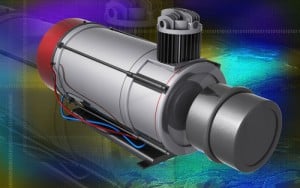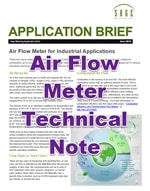In industrial processes, thermal mass flow meters effectively measure and monitor compressed air to determine where air flow is being used and quantifying compressed air leaks. We explore the topic at length in a new Sage Metering white paper, and here I share key findings.
Where is Compressed Air Used?

Compressed air is found in pneumatics (including HVAC control systems, air tools, and pneumatic posts), vehicle propulsion, air-start systems in engines, refrigeration systems, conveying, automated equipment, and controls and actuators, and spraying cooling.
Compressed Air Flow Monitoring
Industrial air compressors use more electricity than the majority of other types of equipment. They regularly account for as much as a third of the energy expenditure in an industrial plant. A thermal mass flow meter can be used in energy management systems to help determine at any given time the optimal number of compressor units needed for the operation. This is determined by evaluating excessive air consumption and ascertaining the compressed air usage time of day.
Compressed Air Leaks
 It is a fact that compressed air leaks are a significant source of wasted energy, draining as much as 30% of the equipment’s productivity. This raises the cost of the produced compressed air. Additionally, the leaks increase the equipment’s runtime, elevating maintenance costs, and reducing the compressor’s service life. Also, leaks cause uneven line pressures, and the air operated tools perform less efficiently, which impedes production efficiency.
It is a fact that compressed air leaks are a significant source of wasted energy, draining as much as 30% of the equipment’s productivity. This raises the cost of the produced compressed air. Additionally, the leaks increase the equipment’s runtime, elevating maintenance costs, and reducing the compressor’s service life. Also, leaks cause uneven line pressures, and the air operated tools perform less efficiently, which impedes production efficiency.
While the leaks may be in any part of the compressed air system, they are more prevalent in specific areas, like condensate traps, couplings, fittings, filter-regulator assemblies, flanges, packing, thread sealants, hoses, quick disconnects, pipe joints, valves, tubes, or point-of-use devices.
Eliminating Compressed Air Leaks
There is a substantial opportunity to save in energy costs by eliminating the compressor leaks. An example illustrated in our recent white paper, “The Use of Thermal Mass Flow Meters in ISO 50001 Energy Management Systems,” revealed that when identifying and repairing ten small leaks in a compressor line, an industrial facility saved nearly $70,000 a year.
Methods to Identify Air Leaks
Compressed air leaks can be detected with an ultrasonic acoustic detector, gas leak detection compounds, and the use of thermal mass flow meters. While the ultrasonic acoustic detector and gas leak detection compounds pinpoint the leaks’ locations, thermal mass flow meters can determine the leak or leaks’ extent and quantify the wasted energy.
Thermal Mass Flow Meters
The previously mentioned white paper is a helpful resource explaining how thermal mass flow meters are useful for compressed air flow measurement to determine where the air is being used and the relative amounts of leaks. For more detailed information on using thermal mass flow meters in this application, download the white paper.
Compressed Air System Audits
In addition to this application, specialists who perform compressed air systems have discovered that using portable thermal mass flow meters can determine energy consumption and perform valuable leak surveys. This application is also discussed at length in the paper.
Compressed Air Snags and 7 Ways Thermal Mass Flow Meters Help

